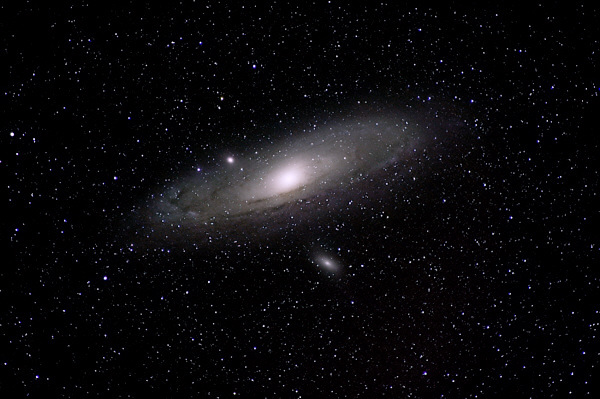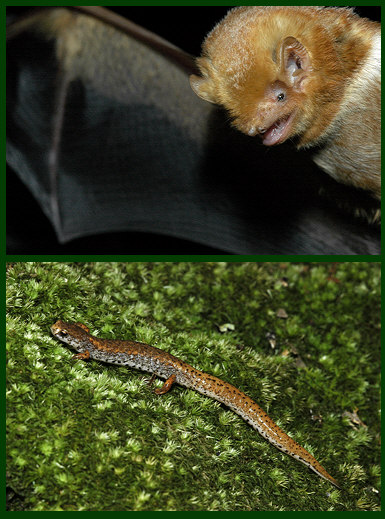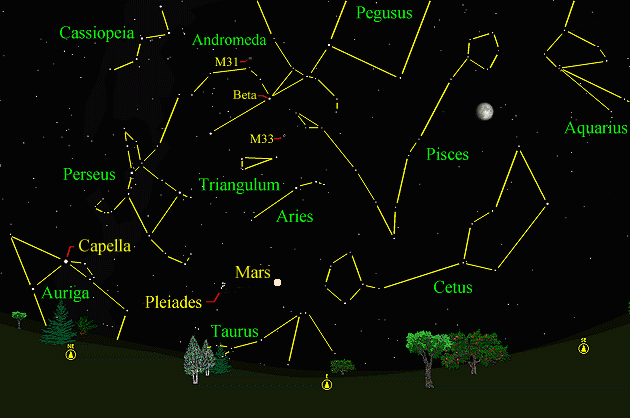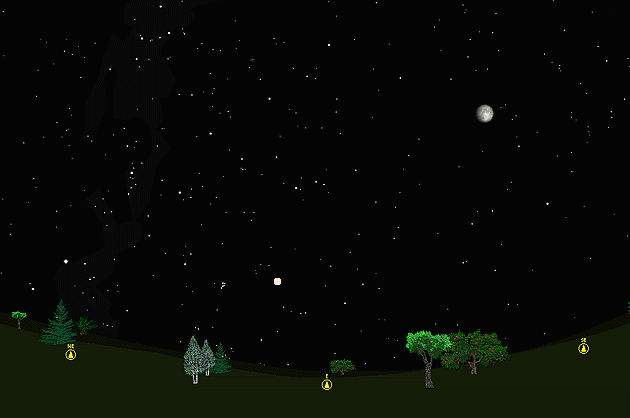The purpose of this feature is to give scout leaders, educators and naturalists an idea of some of the natural events coming up each month. We will try to cover a variety of natural events ranging from sky events to calling periods of amphibians, bird and mammal watching tips, prominent wildflowers and anything else that comes to mind. We will also note prominent constellations appearing over the eastern horizon at mid-evening each month for our area for those who would like to learn the constellations. If you have suggestions for other types of natural information you would like to see added to this calendar, let us know! Note: You can click on the hyperlinks to learn more about some of the featured items. To return to the Calendar, hit the "back" button on your browser, NOT the "back" button on the web page. All charts are available in a "printer friendly" mode, with black stars on a white background. Left clicking on each chart will take you to a printable black and white image.
Notes and Images From September 2005
The majestic spiral galaxy Messier 31 sails high overhead on these cool fall nights. Seeing it well requires clear, moonless skies far away from city lights. At a distance of around two and one half million light years, it is one of the most distant objects visible to the naked eye. In 1610, Simon Marius described its appearance in a small telescope as looking like," the light of a candle shining through horn." My favorite view is through binoculars. Its location in the constellation Andromeda is shown on the star charts below.
Observing subjects a little closer to home, we participated in a Tennessee Wildlife Resources Agency wildlife survey at Bear Hollow Mountain Wildlife Management Area. Target species included small mammals, reptiles and amphibians, fish, snails and bats. This Red Bat was mist netted, measured and released. Tree dwellers, Red Bats rarely venture far into caves. Their days are spent hanging from tree branches, where they are said to resemble dead leaves. The Four-toed Salamander shown was found by Pete Wyatt of TWRA. As the name suggests, these salamanders have four toes on their rear feet. Most other salamanders have five toes on their rear feet. The white belly of Four-toed Salamanders is boldly spotted with round black spots. Four-toed Salamanders are not common in Tennessee and are a Species of Greatest Conservation Need in the TWRA Comprehensive Wildlife Conservation Strategy.
Sky Events for October 2005: The Orionid Meteor Shower peaks in the morning hours of September 21st, with typical hourly rates of 10-15 meteors per hour in dark skies. Evening Sky: Jupiter starts out the month low in the western sky after sunset and rapidly disappears into the twilight glow as the month progresses. Bright Venus continues to climb higher above the horizon after sunset. Mars and the earth will approach each other to within 43 million miles this month, closer than they will be for the next 13 years. The red planet rises around 7:35 EDT at mid-month, and will be brighter than any other star-like object in the eastern sky. Morning Sky: Saturn rises about 1:00 am CDT at midmonth in Cancer. All times noted in the Sky Events are for Franklin, Tennessee and are Central Daylight Time. These times should be pretty close anywhere in the mid-state area.
Constellations: The views below show the sky looking east at 9:00pm CDT on October 15th. The first view shows the sky with the constellation outlined and names depicted. Star and planet names are in yellow. Constellation names are in green. The second view shows the same scene without labels. Prominent are Cassiopeia, Queen Cassiopeia, Andromeda, Princess Andromeda, Perseus, Triangulum, the Triangle, Aries, the Ram, and Cetus, the Sea Monster. Look above beta Andromedae and see if you can pick out the faint glow of the M31, The Andromeda Galaxy. City dwellers may need binoculars to pick it out. To get the best view, wait until the square is high overhead to look. If you find the Andromeda Galaxy, you might want to try to see M33, another nearby galaxy in Triangulum. Auriga, the Charioteer, with its bright star Capella, and Taurus, the Bull, are rising in the northeast. Look for the Pleiades, a beautiful open star cluster, not far above the eastern horizon. Also known as the "Seven Sisters," this cluster has been known since antiquity. Look to the right (south) of the Pleiades for bright Mars.
On Learning the Constellations: We advise learning a few constellations each month, and then following them through the seasons. Once you associate a particular constellation coming over the eastern horizon at a certain time of year, you may start thinking about it like an old friend, looking forward to its arrival each season. The stars in the evening scene above, for instance, will always be in the same place relative to the horizon at the same time and date each October. Of course, the planets do move slowly through the constellations, but with practice you will learn to identify them from their appearance. In particular, learn the brightest stars for they will guide you to the fainter stars. Once you can locate the more prominent constellations, you can "branch out" to other constellations around them. It may take you a little while to get a sense of scale, to translate what you see on the computer screen or what you see on the page of a book to what you see in the sky. Look for patterns, like the stars that make up Cassiopeia. The earth's rotation causes the constellations to
appear to move across the sky just as the sun and the moon appear to do.
If you go outside earlier than the time shown on the charts, the constellations
will be lower to the eastern horizon. If you observe later, they will
have climbed higher. As each season progresses, the earth's motion around the sun causes the constellations to appear a little farther towards the west each night for any given time of night. The westward motion of the constellations is equivalent to two hours per month. A good book to learn the constellations is H. A. Rey's
classic, The Stars, A New Way to See Them. Rey's depictions of the
constellations and witty commentary are terrific. A good general reference book on astronomy is the Peterson
Field Guide, A Field Guide to the Stars and Planets, by Pasachoff.
The book retails for around $14.00. A good beginners software program for learning the night sky
is the Starry Night Beginner program. Visit the Starry Night web site at
www.starrynight.com The program retails for around $30.00 and
contains a wealth of information. Amphibians:
The frog and toad choruses continue to diminish in October, but some frogs and toads are still calling. Another name for the Spring Peeper is the "Autumn Piper", and these small frogs can be heard calling from patches of woods in the fall. On cool October nights, Southern Leopard Frogs sometimes call and breed as the cooler temperatures mirror their early spring breeding period. Upland Chorus Frogs sometimes give a very dry, raspy version of their call in October. You can locate many of the frogs and toads that have been calling more frequently earlier in the year by driving the back roads slowly on rainy nights. This is a two person job. One person watches the road for amphibians and one person looks out for other vehicles. Anything over about 15mph is "speeding."
Birds: Fall migration continues. Try to get out and bird as often as you can. Recommended: Bird Finding in Tennessee, Michael Lee Bierly. A classic guide to finding birds in Tennessee. The Sibley Guide to Birds, David Allen Sibley The Sibley Guide to Birds of Eastern North America, David Allen Sibley This new Sibley Guide covers only eastern North America, is quite compact, and is less expensive than the larger Sibley. An inexpensive guide for beginners is the Golden Guide for Birds.
Archives (Remember to use the back button on your browser, NOT the back button on the web page!)
Natural Calendar
September 2005
Natural Calendar
February 2005
Natural Calendar
December 2004
Natural Calendar
November 2004
Natural Calendar
September 2004
Natural Calendar
February 2004
Natural Calendar
December 2003
Natural Calendar
November 2003
Natural Calendar
September 2003 Natural Calendar February 2003 Natural Calendar December 2002 Natural Calendar November 2002 Nature Notes Archives: Nature Notes was a page we published in 2001 and 2002 containing our observations about everything from the northern lights display of November 2001 to frog and salamander egg masses. Night scenes prepared with Starry Night Pro software All images and recordings © 2005 Leaps
|




